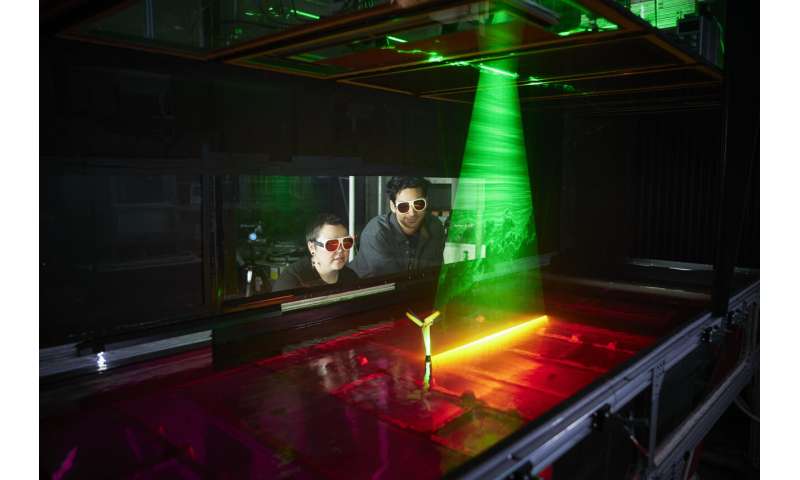Combining computational methods and experimental techniques to unlock floating offshore wind potential

A collaboration between researchers from Johns Hopkins Whiting School of Engineering (WSE) and Portland State University (PSU) aims to help unlock the vast potential of floating offshore windfarms in the United States by improving understanding of wind-wave-turbine interactions, which--if not accounted for properly--can greatly reduce the power output of a group of wind turbines.
The project combines developing a new computational method for enhancing the accuracy of large eddy simulations (LES)—a mathematical computer model that depicts the wind field within floating offshore windfarms, with advanced experimental techniques using a state-of-the-art wind tunnel/wave tank facility at PSU. By integrating both computational and experimental methods, which are usually used separately in offshore wind research, the team aims to develop more accurate tools for the design and optimization of wind farms in the deep ocean.
"One of the challenges to floating offshore windfarms is we don't have test beds. You can't go out to sea, build a test windfarm, and see how it performs. It's just too expensive," said project Co-Principal Investigator Dennice Gayme, a professor of mechanical engineering at the Whiting School of Engineering and member of the Ralph O'Connor Sustainable Energy Institute (ROSEI) leadership council. "Most studies focus on LES simulations or lab experiments and don't look at how to bridge the gap between the two, which is key to developing a complete understanding of the system."
"This proposal is exciting because it's incredibly well-rounded and brings together a pair of universities that have a history of excellence in wind energy research," said Ben Hallissy, a technology manager with the Department of Energy's (DOE) Wind Energy Technologies Office (WETO). "It uses a combination of modeling advancements and scaled experimental results to answer some fundamental questions; for example, how do we better predict the interaction of the wind, waves, and turbines, and how do we learn as much as possible from cost-effective small-scale experiments in the laboratory before scaling up and putting turbines in the ocean?"
Unlike traditional offshore wind turbines that are attached directly to the ocean floor, floating windfarms stand on buoyant structures that are anchored to the ocean bed by mooring lines. This allows placement in deep ocean waters, where about two-thirds of U.S. offshore wind energy potential exists, according to WETO.
But turbines on platforms that move with the water make it difficult to design windfarms in a way that maximizes their energy potential. Computationally, a major challenge to creating LES for effective windfarm design is accurately reflecting wind flow over always-moving waves with multiple wavelengths and complicated shapes.
Project Principal Investigator Charles Meneveau, a professor of mechanical engineering at WSE and an associate researcher with ROSEI, explains two conventional methods for representing wind flow over moving water. The classic method assigns a general "roughness length" number to it, allowing for quicker but less precise simulations. The other method uses a computational grid that adapts to the wave. This approach offers greater accuracy but is quite difficult and time-consuming to create, making it impractical for most common use.
In this work, Meneveau and Gayme propose an intermediate approach, combining a less precise grid that doesn't follow the waves, with a variable forcing term that represents the pressure force along the water's surface.
"We can get accurate results using this model by combining the better features of both the faster, less accurate method, [and] the slower, more exact one," Meneveau said. "Our model reflects different moving waves with peaks and troughs but does so quickly and accurately. It can also factor in a moving platform with a turbine on top of it. It works quickly but provides the critical details."
The experimental aspects of the project will be led by Raúl Bayoán Cal, a professor of mechanical and materials engineering at PSU. His lab facility features a test length that is five meters long, with a wave tank with multiple small turbines floating on the water surface. Most groups studying wind turbines are limited to testing a single turbine at a time, making it more challenging to see how the turbines interact with each other.
"What we have is much smaller than an actual floating wind farm, but our platform enables the measurement of many different factors simultaneously, including dynamics of turbines, power extracted from turbines, motion of the waves, and the flow behind the turbines," Cal said. "We can also recreate various environments where the wind and waves are forced in different ways, meaning my group can study a multitude of conditions that are observed in offshore wind farms, helping us prepare a wind farm for a given scenario."
Before joining the faculty at PSU, in the late 2000s, Cal was a postdoctoral fellow advised by Meneveau at Hopkins, leading to this and many other collaborations between the two groups, including one of the first scaled windfarm experiments to ever happen in a wind tunnel.
"A big reason that you don't see collaborations between groups that work in the computational and lab spaces is relationships. Knowing how myself, Charles, and Dennice all work has played a big part in us partnering," Cal said. "When working with both computational and experiments, the questions need to be really defined and within that we can say "What are the computational elements that can be exploited in a lab experiment and vice versa." It's easier to find answers to those questions when you have a history with your partners."
Provided by Portland State University